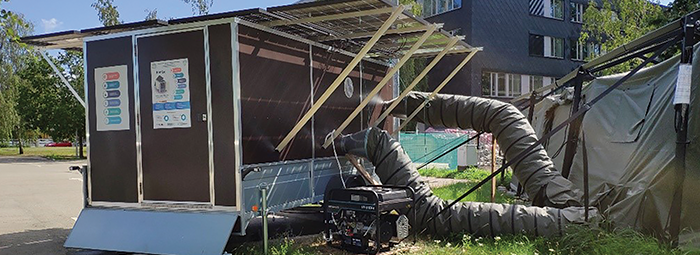
©2021 This excerpt taken from the article of the same name which appeared in ASHRAE Journal, vol. 63, no. 4, April 2021.
About the Authors
Raimonds Bogdanovics is a scientific assistant, Anatolijs Borodinecs is a professor, and Jurgis Zemitis and Aleksandrs Zajacs are researchers at the Heat, Gas and Water Technology institute in the Faculty of Building and Civil Engineering at Riga Technical University, in Riga, Latvia.
The importance of mobile energy sources cannot be overestimated. In many fields, such as military, scientific or travel, it may not be possible to connect to a stationary electricity grid. For this reason using a diesel generator is common for generating electricity to charge devices and provide HVAC for temporary shelters. This article investigates a newly designed and built mobile modular energy unit (MMEU) with photovoltaic (PV) panels to provide heat and ventilation for a tent in Riga, Latvia, EU.
Using a diesel generator to generate electricity is not an ideal solution. This is because of its noise and dependence on liquid fuel. According to manufacturing data, the noise level at 1 m (3 ft) distance is 75 to 85 dB(A), which is classified as loud noise. Liquid fuel requires large amounts of storage, creates air pollution and has a risk of explosion.
One solution to generate electricity autonomously and in an eco-friendly manner is using PV panels. For example, a mobile PV system coupled with a fuel-fed generator as a reserve energy source for nomadic camps in Norway and Russia was modeled, and it was concluded that by using LED lighting and certain schedules of device charging, PV systems are economically beneficial; however wide seasonal and daily variation in solar flux, as well as battery capacity reduction due to low temperatures, should be considered.
With the increased interest in renewable and sustainable energy solutions, the topic of solar energy has become very popular. For instance, to show the capability of solar energy for many applications, McCulley describes the detailed design and sizing of a portable PV system used in undergraduate research projects and for community events. Other researchers described and tested a portable solar-powered cooling system (PV panels on top of a car) for vehicle cabin cooling.
Proper design of the unit is very important in the case of the power-to-weight parameter and flexibility. For a portable system, energy density is more important than efficiency and should be used for selecting and designing such systems. These two objectives may lead to a very different design, operation and/or performance.
The military actively researches using portable energy sources. For example, The U.S. Naval Air Warfare Center Weapon Division tested a 5 kW trailer-mounted regenerative fuel cell system coupled with an array of solar panels to provide the command center with electric power. The field tests and energy models of the Smart and Green Energy (SAGE) project6 show fuel reductions for a camp from 49% to 53% (for a 5,000 soldier base camp) to 74% to 84% (for 150 to 600 soldiers) depending on location, with greater impact in a cold climate. The project includes a base camp energy management system, a solar hot water system, a solar photovoltaic array (it can produce up to 12% of daily base camp energy needs), an energy storage system and energy-efficient shelters for troop housing. The heat pumps and the smart microgrid provide the main impact.
Read the Full Article
ASHRAE Members have free access to the full-text PDF of this article as well as the complete ASHRAE Journal archives back to 1997 in the Free Member Access Area.
Non-members can purchase features from the ASHRAE Bookstore. Or, Join ASHRAE!
Return to Featured Article Excerpts
Return to ASHRAE Journal Featured Article Excerpts